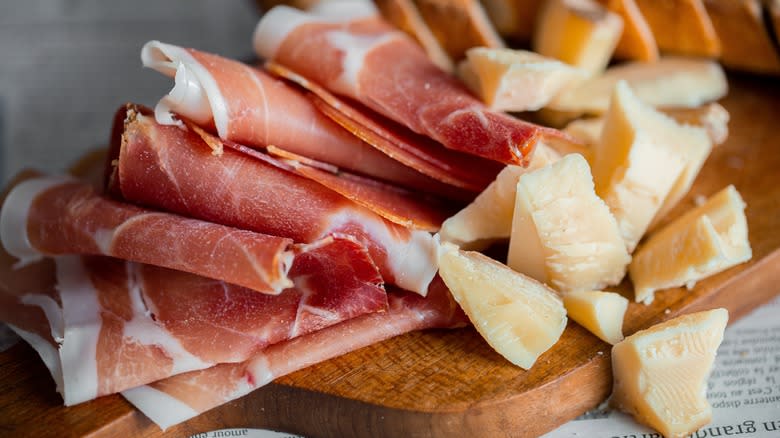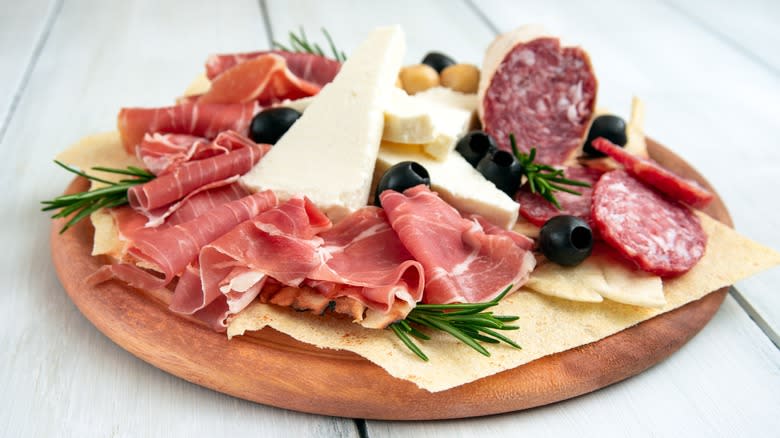Why Parmigiano Reggiano Is The Perfect Cheese Pairing For Prosciutto Di Parma

Some foods are made for each other, and that doesn't get more literal than the cheese and meat pairing of Parmigiano Reggiano and prosciutto di Parma. There is a chef's saying, often associated with wine: "What grows together goes together." Taken generally, this refers to local ingredient pairings, dating back to a time when limited trade, travel, and technology meant people were forced to make do with the products made in and around their homes. Even today, with the ability to ship food from all over the world, something rings true in that phrase, that produce, animals, and spices that are grown together blend together in a special way.
Of course, cheese and cured meat aren't grown, they're made, but those local origins undoubtedly play into why some things like Parmigiano Reggiano and prosciutto di Parma are so perfect together. Food is imbued with a sense of place. Parmigiano Reggiano is produced in the Emilia-Romagna region of Italy, in the Southern Po Valley, which also encompasses the city of Parma, home of its eponymous prosciutto. The production of these two beloved foods is intimately intertwined in a way that adds to their complementary nature.
Read more: The Best Meat For Your Charcuterie Board Isn't One You'd Expect
Parmigiano Reggiano And Prosciutto Di Parma Have Similar Italian Roots

Both Parmigiano Reggiano and prosciutto di Parma date back over a thousand years. Prosciutto is older, with Roman sources from 100 BC mentioning the high quality of air-cured ham from Parma. Prosciutto di Parma is produced to this day using the air-curing process, and it takes advantage of Parma's unique climate to cure the meat without smoking or cooking. The breezes from the Adriatic sea that flow around the city and cure the meat are thought to lend it a special flavor, and it's exclusively made with one Italian breed of pig.
Parmigiano Reggiano dates back to the Middle Ages when monks produced the hard cheese as a long-lasting food. Its deep flavor comes from the unique microbiological community in the local flora, which gets imparted into the raw milk used to make the cheese. Its impressiveness has been recognized for centuries, with attempts to safeguard the art and protect the name of the cheese dating back to the 17th century.
It's not just history and geography that tie the two together. The milk Parmigiano Reggiano is made from is only allowed to come from cows that are fed locally foraged grass and grains, and the whey byproduct of the cheese production is fed to the local pigs that get turned into prosciutto di Parma. One feeds into the other, and both are intimately tied to the land.
Beyond A Basic Meat And Cheese Pairing

At a fundamental level, Parmigiano Reggiano and prosciutto di Parma are a match made in heaven for the same reason any meat and cheese pairing is great: harmonious flavors and textures. Prosciutto has a rich, meaty taste, with a distinct funk from the long curing process. It's thinly sliced and crossed with a generous amount of fat, which makes it almost buttery. The salt is balanced out by a surprising sweetness. In contrast, Parmigiano Reggiano is sharper and more acidic, with an earthy and nutty flavor. Combined you get the fat, meat, and aged complexity from the prosciutto and the intense umami notes and tang from the cheese.
You also cannot ignore the pleasing textural contrast. Aged parmesan is sturdy, crumbly, and even has a little bit of crunch from crystallized amino acids that are a natural product of the cheesemaking process. Prosciutto di Parma is famed for its soft texture and melt-in-your-mouth sensation, so a harder cheese like Parmigiano Reggiano is a welcome companion. After all the history and all the work, sometimes pairings come down to simple things like that.
Read the original article on Tasting Table.

